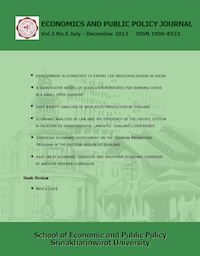COST BENEFIT ANALYSIS OF BIOPLASTIC PRODUCTION IN THAILAND
Main Article Content
บทคัดย่อ
This paper aimed to analyze the net social benefits from switching petroleum-based plastic to bioplastic based on Cost-Benefit Analysis (CBA). The status quo was no PLA production in Thailand and another case is having PLA production based on the assumption that the HDPE production was not replaced by the PLA production. This paper calculated cost of PLA production from two cases: 1) cassava root to PLA resin and 2) cassava starch to PLA resin. The cost structure of PLA production comprises of investment cost, direct production cost and indirect environmental cost. Total costs and benefits of PLA and HDPE production were calculated on the basis of 100,000 tonnes. For case 1, the integrated PLA production provided positive net benefit as 7.34 millions USD due to large benefit from selling cassava meals. Without the revenue from cassava meal, the net benefit is negative (-297.66 millions USD). Plus CDM implementation, the case 1 gains more benefit from selling carbon credit than another case due to less amount of wastewater produced. In comparison to PLA production, the net benefit of HDPE production is -186.66 millions USD. Therefore, only the PLA production under case 1 can be competitive with the HDPE production. The case 2 was selected as Status quo for calculation of net present values (NPV) using real discount rate of 1.89 %. Moreover, NPV of three options: 1) change in benefit due to expected PLA price development, 2) change in cost due to technological development and 3) combination of option 1 and 2 were calculated. All three options provided positive NPV. The sensitivity analysis was conducted based on the variation in real discount rates; 1.89 % (status quo), 4.5% and 7.0%. All results were insensitive to the increase of real discount rates.
Article Details
ประเภทบทความ
บทความวิจัย
สงวนลิขสิทธิ์ © 2553 คณะเศรษฐศาสตร์ มหาวิทยาลัยศรีนครินทรวิโรฒ
คณะเศรษฐศาสตร์ มหาวิทยาลัยศรีนครินทรวิโรฒ จัดพิมพ์วารสารเศรษฐศาสตร์และนโยบายสาธารณะ เพื่อเผยแพร่บทความวิชาการทางเศรษฐศาสตร์ นโยบายสารธารณะ และสาขาอื่นๆที่เกี่ยวข้อง ทัศนะและข้อคิดเห็นใดๆ ที่ปรากฏในวารสารเป็นความคิดเห็นส่วนตัวของผู้เขียน โดยบทความที่ได้รับการตอบรับจะถือเป็นลิขสิทธิ์ของคณะเศรษฐศาสตร์ มหาวิทยาลัยศรีนครินทรวิโรฒ
บรรณาธิการ อาจารย์ ดร.พลพัธน์ โคตรจรัส


